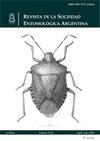Synanthropic spiders’ diversity (Arachnida, Araneae) in the urban zone of Morelia citiy, Michoacan, Mexico. How much does the time of construction of the houses influence?
IF 0.5
4区 农林科学
Q4 ENTOMOLOGY
引用次数: 3
Abstract
Spiders have been used to evaluate changes in systems by anthropization effect, some species showing sensitivity to gradual and drastic changes such as urbanization, and other species have been documented as tolerant to this effect. The goal of this work was to describe the change in the spider community in relation to the age of buildings. at the west of Morelia, Michoacán, Mexico. Three categories of construction time and the neighboring vegetation as the pre-urbanization environment were used for comparison. Using direct capture, pit-fall traps and beating nets, 3,619 spiders were collected, and 3,219 (315 males, 630 females and 2,274 immatures) were used for the analysis after removal juveniles that was not possible to identify. A total of 28 families, 93 genera, 47 species and 55 morphospecies were identified. This represents the greatest richness and abundance recorded in urban environments of the country. It describes changes in alpha diversity from colonization in recent constructions to those built 17 years ago. I t was observed that abundance, richness, and diversity decrease with the age of a building, but with high equitability in every age of construction. The age of a building is an important factor for the process of succession in urban environments.墨西哥米却肯州Morelia city城市地区的同人类蜘蛛多样性(蛛形纲、蛛形纲)。房屋的建造时间有多大影响?
蜘蛛被用来通过人为化效应来评估系统的变化,一些物种对城市化等渐进和剧烈的变化表现出敏感性,而其他物种则被证明对这种影响具有耐受性。这项工作的目的是描述蜘蛛群落随建筑年代的变化。位于墨西哥米却肯州莫雷利亚西部。采用三类建设时间和邻近植被作为城市化前的环境进行比较。使用直接捕获、陷阱和抽打网,收集了3619只蜘蛛,并使用3219只(315只雄性,630只雌性和2274只未成熟蜘蛛)在清除无法识别的幼蛛后进行分析。共鉴定出28科93属47种55形态种。这代表了该国城市环境中有记录以来最丰富的资源。它描述了阿尔法多样性的变化,从最近建筑的殖民化到17年前建造的建筑。据观察,丰富性、丰富度和多样性随着建筑的使用年限而减少,但在每个建筑年代都具有很高的可等性。建筑的年代是城市环境演替过程中的一个重要因素。
本文章由计算机程序翻译,如有差异,请以英文原文为准。
求助全文
约1分钟内获得全文
求助全文
来源期刊

Revista De La Sociedad Entomologica Argentina
Agricultural and Biological Sciences-Insect Science
CiteScore
0.80
自引率
20.00%
发文量
31
审稿时长
20 weeks
 求助内容:
求助内容: 应助结果提醒方式:
应助结果提醒方式:


